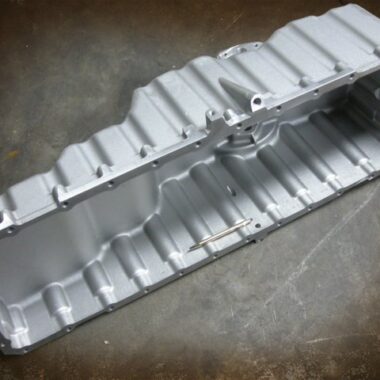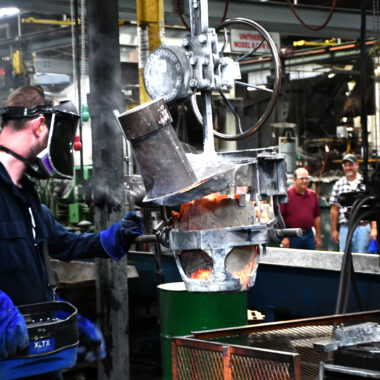Accomplishing Excellence in Aluminum Casting: Insider Tips and Techniques
Accomplishing Excellence in Aluminum Casting: Insider Tips and Techniques
Blog Article
Discovering the Different Methods of Light Weight Aluminum Spreading: A Comprehensive Guide
Aluminum casting stands as a basic process in the creation of many products we run into daily, from elaborate automotive elements to household components. Understanding the varied methods made use of in aluminum spreading is essential for suppliers seeking accuracy and efficiency in their manufacturing procedures - aluminum casting. As we begin on this expedition of the various methods involved in aluminum spreading, we uncover a globe where innovation and custom merge to shape the products that shape our modern globe
Sand Spreading Method
Using among the oldest and most commonly made use of methods in aluminum casting, the sand spreading method involves producing mold and mildews from a mixture of sand and a binder material. This strategy is very versatile, economical, and ideal for producing a wide variety of sizes and shapes, making it a prominent option in numerous sectors.

Light weight aluminum, heated up to its melting point, is then poured into the mold, filling the tooth cavity. After solidifying and cooling, the sand mold is escaped, exposing the aluminum spreading. This technique enables the production of complex geometries and is well-suited for both low and high volume manufacturing runs.
Financial Investment Casting Technique
Having actually checked out the sand casting technique, a refined strategy to aluminum spreading is the investment spreading technique, which offers distinct advantages in terms of accuracy and surface coating. Investment spreading, additionally recognized as lost-wax casting, is a procedure that entails producing a wax pattern that is covered with a ceramic covering.
In addition, financial investment casting is recognized for its outstanding dimensional precision and tight tolerances, making it a recommended method for creating parts that need limited specs. On the whole, the investment spreading strategy is a flexible and efficient method for producing premium light weight aluminum elements.
Irreversible Mold Refine

One of the key benefits of the Irreversible Mold Process is its capability to produce parts with a finer grain structure, leading to enhanced mechanical properties. Additionally, the recyclable nature of the steel mold enables the manufacturing of a a great deal of get rid of constant high quality. This technique is commonly other made use of in the automotive, aerospace, and marine industries for making elements such as engine pistons, wheels, and architectural components. By leveraging the Long-term Mold and mildew Refine, producers can accomplish economical production of aluminum components with excellent dimensional precision and surface area coating.
Die Casting Strategy
In comparison to the Irreversible Mold Refine, the Die Casting Strategy for light weight aluminum spreading involves using a reusable steel mold to produce intricate parts with high dimensional precision. This approach is commonly made use click this of in different markets due to its ability to successfully manufacture complicated shapes with slim wall surfaces and exceptional surface area coatings.
Die casting usually starts with the prep work of the steel mold and mildew, which is after that splashed with a lubricating substance to help with the elimination of the solidified aluminum. The mold is shut, and molten aluminum is infused under high stress right into the dental caries. As soon as the light weight aluminum cools down and strengthens, the mold and mildew opens, revealing the completed part.
Among the crucial benefits of die casting is its high manufacturing price, making it a cost-effective option for massive production. Furthermore, parts created via die casting exhibit exceptional stamina and durability compared to those made with various other casting approaches. This method is specifically suitable for applications calling for intricate designs, limited resistances, and high repeatability.
Centrifugal Casting Approach
Exactly how can the Centrifugal Spreading Approach boost the efficiency and high quality of light weight aluminum spreading procedures? Centrifugal casting is a method that makes use of centrifugal pressure to disperse liquified steel right into a mold and mildew dental caries. This strategy uses numerous advantages over standard casting approaches.
One key advantage is the superior top quality of the spreadings created. The centrifugal pressure aids to get rid of porosity by pressing any gas or pollutants in the direction of the center of the spreading, causing a denser and more uniform end product (aluminum casting). Additionally, the rotational motion of the mold and mildew makes certain a much more even distribution of the molten steel, leading to boosted mechanical properties and lowered problems
In Addition, the Centrifugal Casting Approach is recognized for its effectiveness. The rapid solidification price achieved try here via this process can add to reduced cycle times, making it an economical solution for high-volume production. The technique permits for the spreading of elaborate shapes and thin-walled parts with convenience, broadening the style opportunities for manufacturers. Finally, the Centrifugal Casting Technique stands out as a trustworthy technique for boosting both the performance and high quality of aluminum spreading procedures.

Final Thought
In final thought, the numerous approaches of aluminum casting give unique advantages and qualities for different applications. Sand spreading supplies flexibility and cost-effectiveness, financial investment casting enables elaborate layouts, long-term mold procedure makes certain high-grade surfaces, die casting gives high production prices, and centrifugal casting creates high-strength components. Understanding the distinctions in between these techniques can assist manufacturers choose one of the most ideal technique for their specific spreading needs.
Having discovered the sand casting approach, a refined method to light weight aluminum casting is the investment casting method, which uses distinct advantages in terms of accuracy and surface area finish. Investment casting, additionally known as lost-wax spreading, is a procedure that includes producing a wax pattern that is covered with a ceramic shell.Exactly how can the Centrifugal Casting Approach enhance the efficiency and quality of aluminum casting processes? In verdict, the Centrifugal Spreading Approach stands out as a reliable technique for enhancing both the efficiency and quality of aluminum spreading processes.
Sand spreading supplies convenience and cost-effectiveness, financial investment casting enables for complex designs, irreversible mold and mildew procedure makes sure top notch surfaces, die casting provides high production rates, and centrifugal casting produces high-strength components.
Report this page